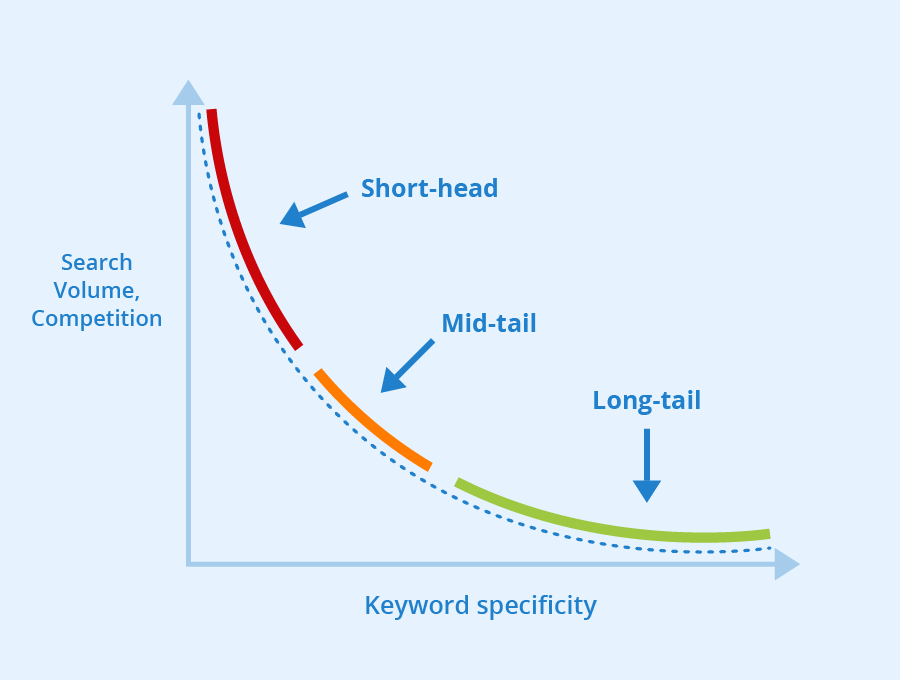
Our guide to do long-tail keyword research for your content
Long-tail keyword research is a great way to find the right keywords for your content. Long-tail keywords are more specific, they target a niche audience and are more likely to have less competition than short-tail keywords.
By targeting long tail keywords it can potentially open up opportunities to rank high in Google SERPs and drive more organic traffic to your website. When used correctly, long-tail keywords can really boost your content strategy and give you an edge over competitors in your space.
The question is how do you do long-tail keyword research? In this blog we will cover the steps involved. Let’s kick start by finding out what are long-tail keywords are and how to find the best ones to grow your content strategy.
So what are Long-tail keywords?
Using long-tail keywords is an excellent way to target a niche audience, although they are longer than more generic keywords and typically contain 3-4 words. The keywords you find will have lower search volume, their competition levels will also be lower, making it easier to get your content noticed.
An example is if you are a business selling clothes, instead of targeting “parka jackets” with your content, you could use something like “high-street black parka jackets” which is much more specific.
When you utilise long-tailed keywords within your content creation strategy, you can potentially reach a more focused audience whilst increasing the chances of your content ranking higher in search engine results pages.
Let’s have a look at easy ways to find specific, relevant and longer key terms to use in your content.
Brainstorm relevant long-tail keywords
For businesses to master consumer search intent and select the perfect keywords for the desired target audience, you need to first be clear what your content is trying to achieve and who it needs to reach and appeal to.
You should brainstorm to select a handful of keywords that you would like to rank organically for by consulting your target personas. Target personas are a fictional representation of your ideal target buyer based on real insights, research and data-led assumptions about their biggest problems and deepest desires. When you have you chosen keywords that is based on your target persona information, you will need to ensure they definitely match your consumer search intent.
Google AdWords Keyword Planner
Utilising the Google’s free Keyword Planner tool will help you generate high traffic terms your prospects are searching for on a monthly basis. You’re looking for long-tail (about 4 words) low competition terms with high traffic. Below, I’ve outlined the steps to help you generate high traffic, low competition long-tail keyword ideas using the tool.
The best content and websites with high domain authorities will find it easier to rank higher for keywords they choose to target. That’s why it makes sense to target low competition keywords – otherwise you’re going to have to work harder to rank for the one keyword and as results aren’t guaranteed like for your competitors with higher domain authorities could be working even harder. If you target low competition keywords, it will allow you to possibly own a space on the first page of Google where your high intent prospects are searching for relevant terms and this is what you want.
Google Search Console reports
This is one of the core things you need to do, which is connect your website to Google Search Console and use Google Analytics. Once you create content, get your website indexed and connect your website to Google Search Console, you’ll start getting reports. These reports will tell you how many impressions and clicks your content earns monthly. You’ll learn which pages get the most clicks and what keywords they appear in search results for.
This is vital because you can potentially see terms you have not thought of that are ranking for your content. You can then choose to further optimise existing posts for such terms or create entirely new posts on these specific terms.
Create a spreadsheet for your targeted long-tail keywords
Sometimes it is better to start your research before you write your content. You can even consider beginning your long-tail keyword research before you craft your content strategy or even content calendar. Simply by creating a spreadsheet of terms you would like to target based on the long-tail keyword research you conducted in the previously and place it in your content strategy. This serves as a reminder to use these terms and can even inspire customer-pleasing ideas for your upcoming blog posts.
Where to use long-tail keywords
When you are using keywords, it is vital that you do not over use keywords within your content. This is because Google views this as keyword padding and you could be penalised for it. When crafting your optimised headline or content, you need to remember that you are writing for people and not specifically search engines. Your content or headline needs to be readable, engaging and enticing but above all it needs make sense to your target audience.
Often the keyword ideas you retrieve from Google can sound random or don’t flow well and sometimes they don’t make sense to your readers exactly as they are. Therefore, if you use a colon or dash to break up your keyword, it could add a whole new meaning and ensure it makes sense to your readers. You won’t get penalised for it as Google will read it and rank it the same as your original keyword without the punctuation mark.
If you need any help with your keyword optimisation or SEO strategy, contact us to book your free consultation today!
 Pinterest
Pinterest Twitter
Twitter Facebook
Facebook

